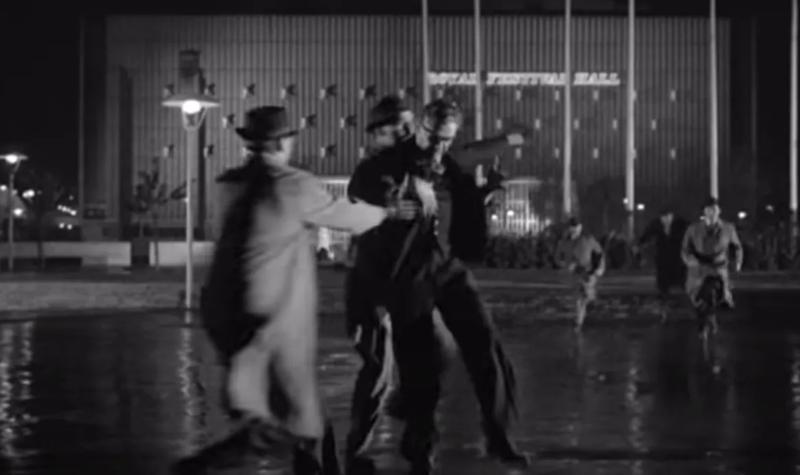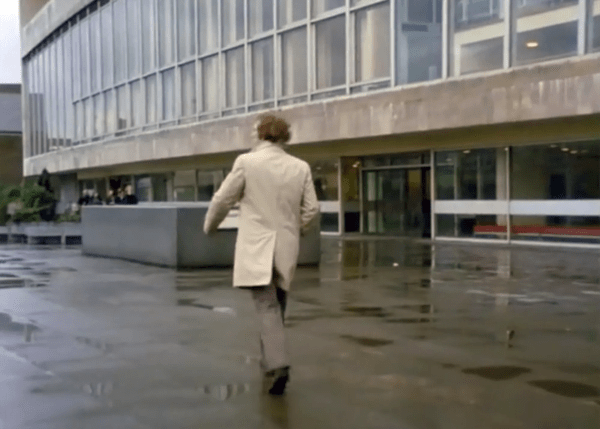Royal Festival Hall on Screen

Across its 70 years the Royal Festival Hall has played host to thousands of memorable concerts and performances. But in that time, our iconic venue has also made a number of appearances on screen too.
From continental crooners to sweary spin doctors, small screen to big screen, the Royal Festival Hall has served as a distinct backdrop for a host of film and television directors. Here are just 10 occasions on which the Royal Festival Hall has appeared on film.
Three Cases of Murder, 1955

Within years of its construction the Royal Festival Hall was already a popular setting for film-makers; so much so that even its construction had been the premise of 1952’s The Happy Family. In 1955 murder triptych, Three Cases of Murder, the Royal Festival Hall was chosen as the setting for its second case. Two friends; George and Edgar fall for the same woman – Elizabeth – and when she is later found dead, each becomes a suspect for her murder. Elizabeth’s relationship with George is formed as the pair take a break from a concert in Royal Festival Hall. Meaning not only are we a filming location, we’re an accessory to murder. Unless Edgar did it, in which case we’re off the hook. So let’s hope Edgar did it.
The Long Arm, 1956

When you watch 1956 film noir The Long Arm, it’s easy to see why the Royal Festival Hall was such a favourite of post-war cinematographers. Standing alone on the South Bank with distinct modern architecture, it is instantly recognisable as the heart of contemporary London. In this film, it’s the scene of the denouement, as Detectives Halliday and Ward conclude their sting on serial safecracker Gilson, who they’d entrapped with rumours of a sizeable bounty in our Royal Festival Hall safes.
Eurovision Song Contest, 1960

In 1960 the Royal Festival Hall went international as the venue for the fifth edition of the singing ‘Grand Prix’ Eurovision. Hosted by Catherine Boyle, the competition was broadcast live to 13 different countries across the continent, and was eventually won by France’s Jacqueline Boyer with ‘Tom Pillibi’. We’ve spared you the singing to just give you the intro above, which shows an initial look around the auditorium with our boxes allocated to different national broadcasters.
Frank Sinatra: In Concert at the Royal Festival Hall, 1971

Though broadcast in 1971, this CBS musical television special was actually filmed in our Royal Festival Hall in November 1970. This was the second, and final concert, of a charity event which had also featured the comedian Bob Hope. Introduced to the stage by royalty, in the form of his former High Society co-star Princess Grace of Monaco, Sinatra delivered a dazzling 50 minute set featuring some of his most well-known and well-loved numbers.
The Sweeney, 1975

Enough music, time for a shouty 1970s police drama to make an appearance. Shut it will ya! It’s The Sweeney! Kipper ties, flared trousers, sideburns the lot, and the eighth episode of their first series. ‘Cover Story’ sees Regan (John Thaw – who was incredibly only 32 when this episode was filmed; how rough were the 1960s?) become romantically involved with a crime journalist. But when she becomes implicated in a major (and yet non-specific) crime, Regan and Carter (Dennis Waterman) must tail her to a very quiet Royal Festival Hall. Who is that mystery man she’s meeting? And also, where the hell is everybody?
The Professionals, 1978

And what’s good enough for one shouty 1970s special agent show is good enough for another. This time it’s The Professionals turn to drop their respective love interests and rock up here for ‘First Night’. This episode began with an Israeli government minister arriving for a concert in our Royal Festival Hall only to be kidnapped as he does so. Cue gunfire, balaclavas, and a lot of screaming as two armed assailants bundle the minister into a waiting hovercraft (yes, hovercraft). Aired in 1978, the show gives you a great look at the river side of Royal Festival Hall before its pedestrianisation and the addition of shops, restaurants.
In The Loop, 2009

It’s not just the auditorium, or the exterior of our Royal Festival Hall which makes it onto screen. For Armando Iannucci’s 2009 film, In The Loop, our modernist hallways and function rooms made an able stand-in for the corridors of power at the UN headquarters in New York. Given many of the scenes filmed here featured the character Malcolm Tucker you’ll understand why there’s not a lot we can show you here on a site without an age restriction, but you can catch sight of our Green Bar in the trailer above.
The Boat That Rocked, 2009

The Royal Festival Hall had a chameleonic onscreen life in 2009; as well as deputising as the UN, it also served as a boat in Richard Curtis’ film The Boat That Rocked. Several scenes were filmed here as our sixth floor St Paul’s Roof Pavilion was completely redressed to double as the office of Government Minister Sir Alistair Dormandy (Kenneth Branagh). In fact it was so well redressed that it’s completely unrecognisable in the film, but if you’ve a keen eye you can spot a cleaner bopping away on the distinctive green ‘net and ball’ carpet of Royal Festival Hall a minute into the film’s trailer (above).
BAFTA Television Awards, 2009 – 2019

Since 2009, the Royal Festival Hall has been beamed into living rooms across the country as the venue for the BAFTA Television Awards. A total of seven ceremonies have been held here in the last decade, with our trademark boxes perhaps the only giveaway in a radically decorated auditorium. The most recent occasion that the awards came to the Southbank Centre was 2019, when Killing Eve picked up a literal stack of awards, including a very popular Best Actress Award for Jodie Comer.
Requiem, 2018

Lastly, one of the most recent dramatic appearances of the Royal Festival Hall on screen courtesy of Netflix show, Requiem. Though most of its six episodes are filmed in Wales the series begins here, where lead character Matilda (Lydia Wilson), a leading cellist, is set to perform. However, unexpectedly, her mother Janice commits suicide, in front of Matilda, sparking a chain of mysterious goings on that leads the cellist away from the stage and back to her homeland.